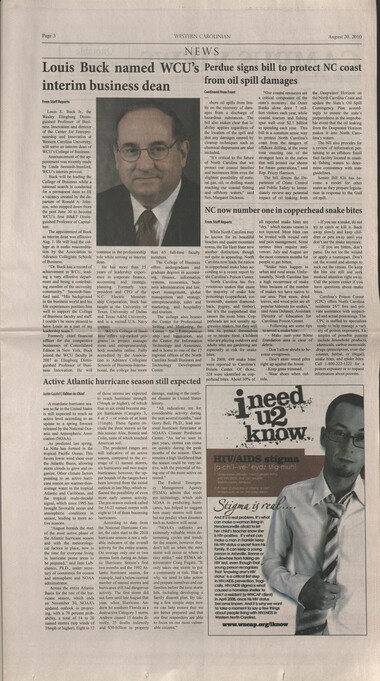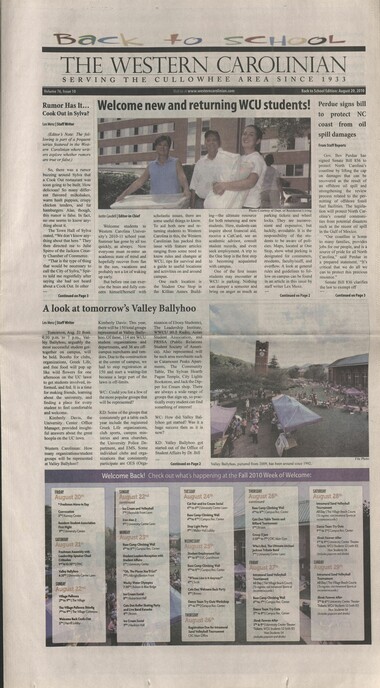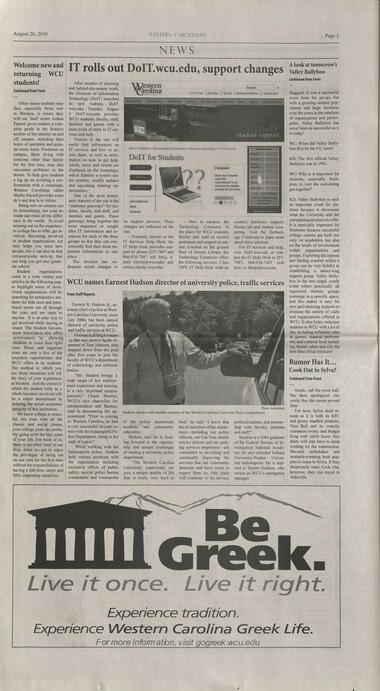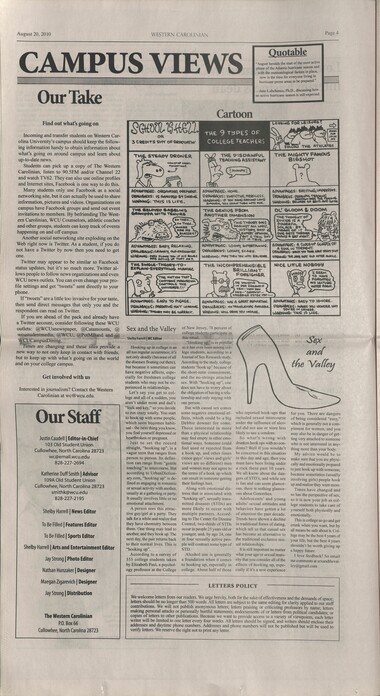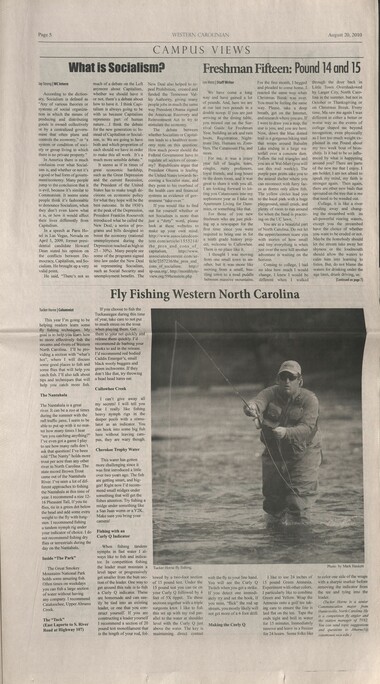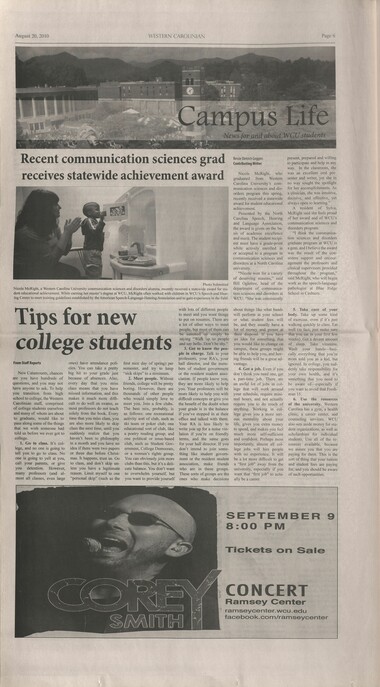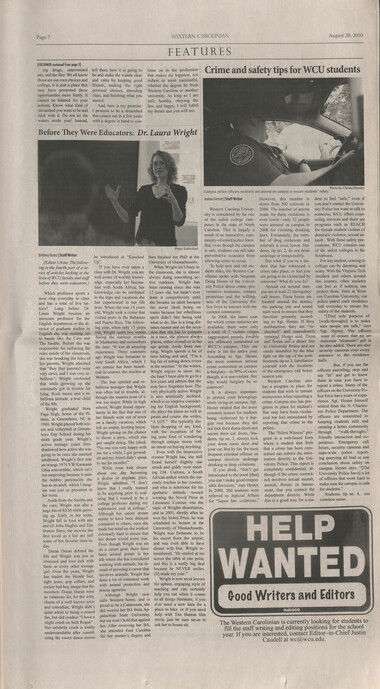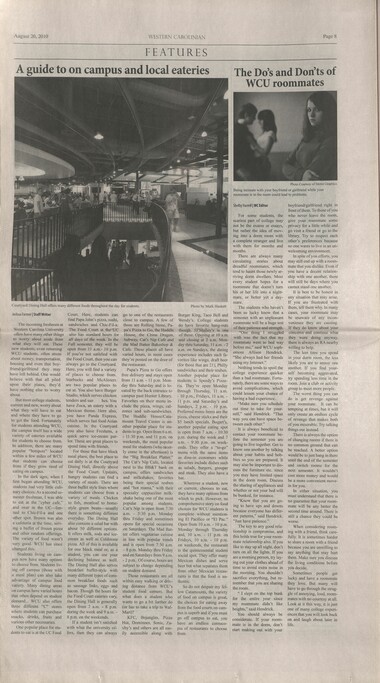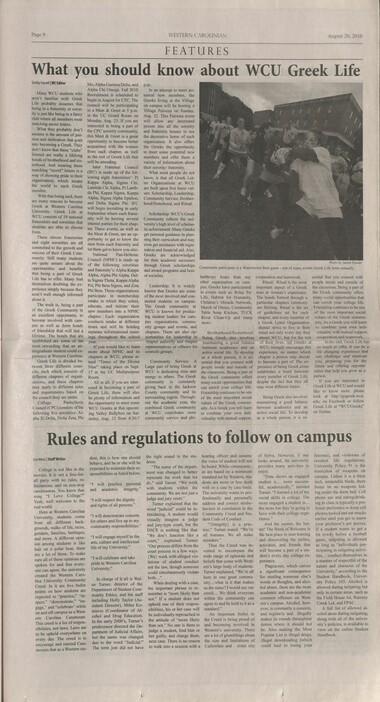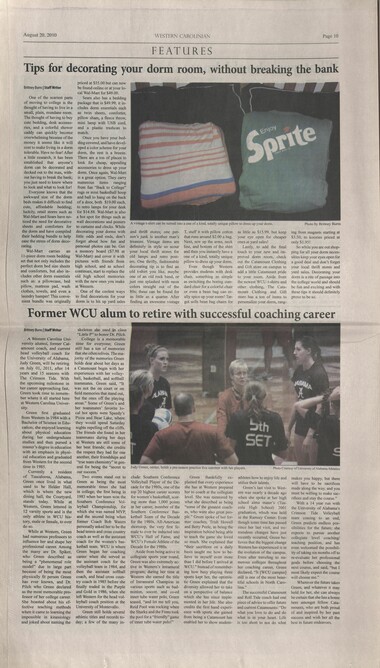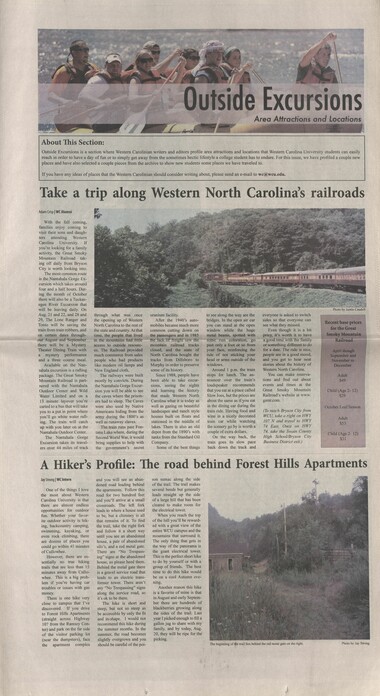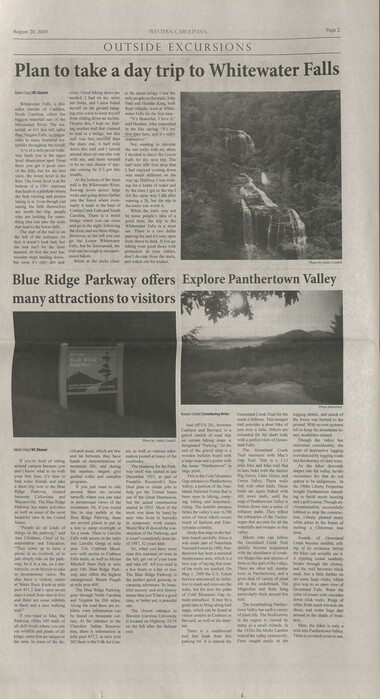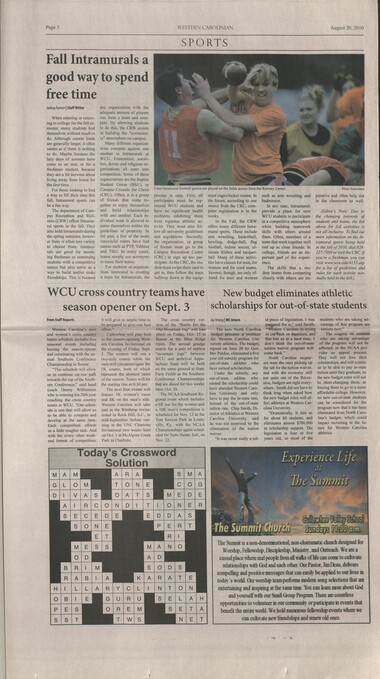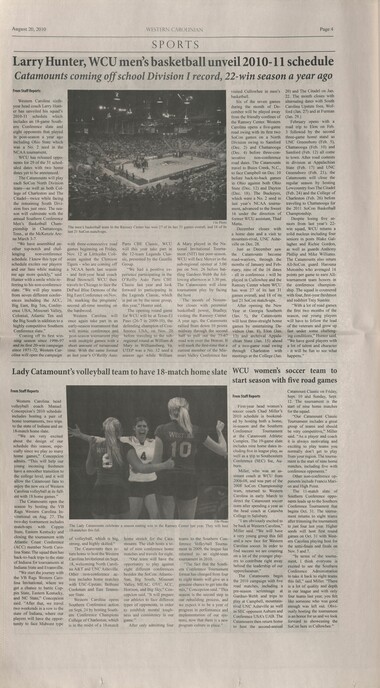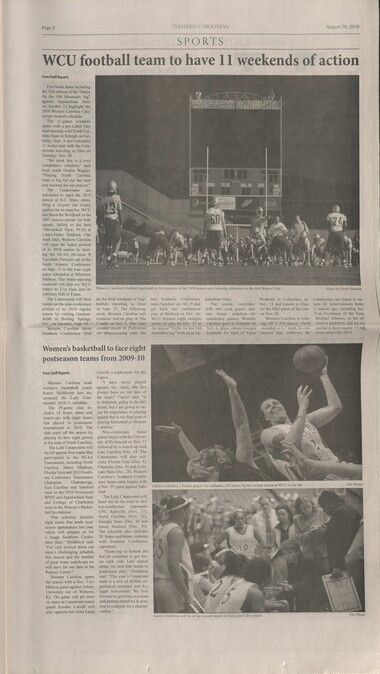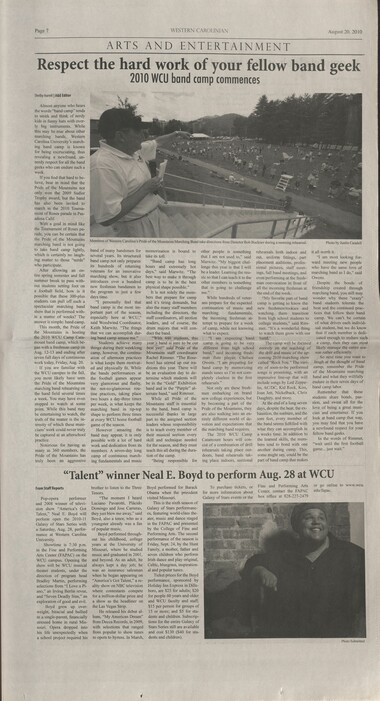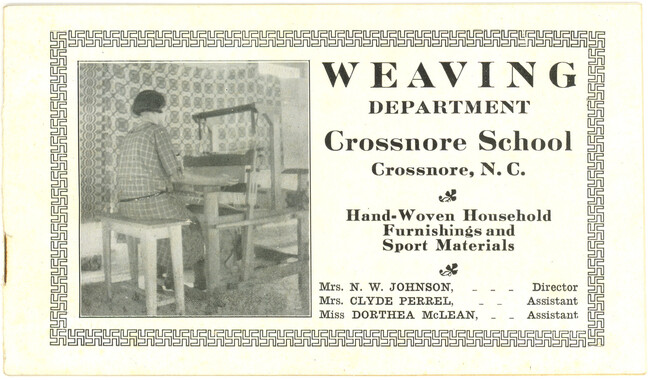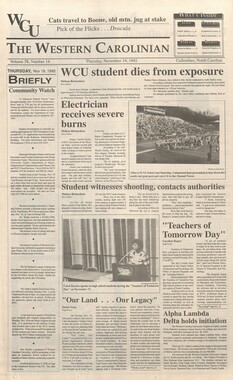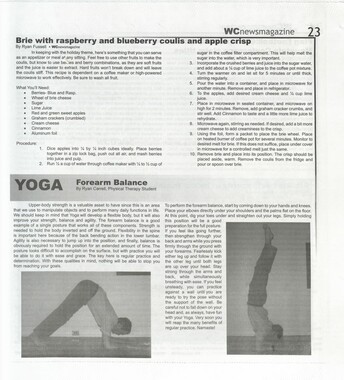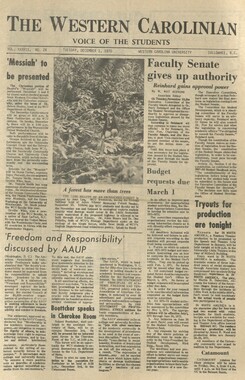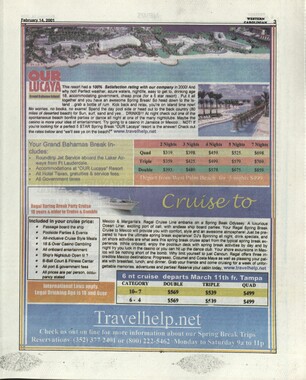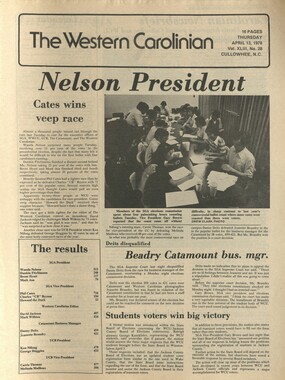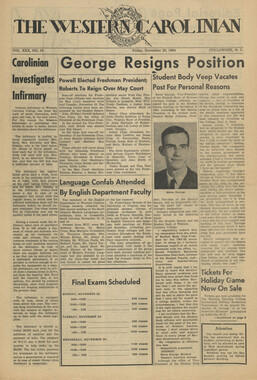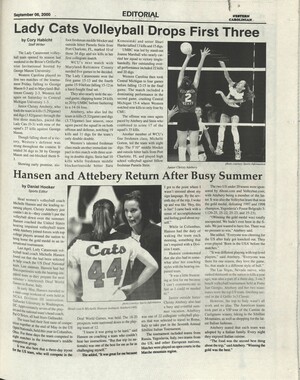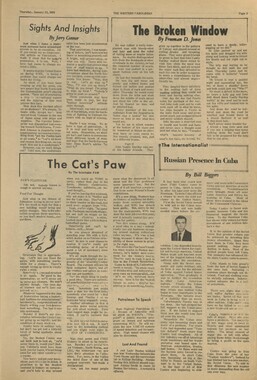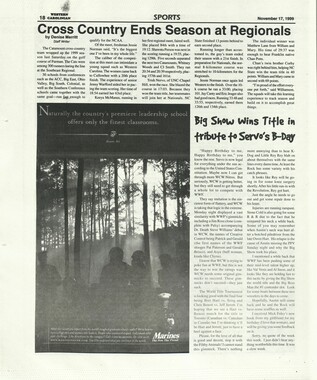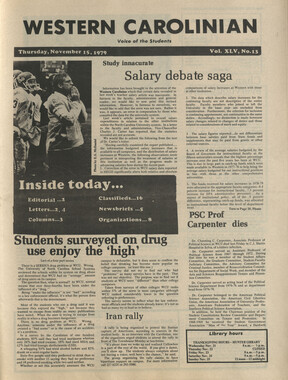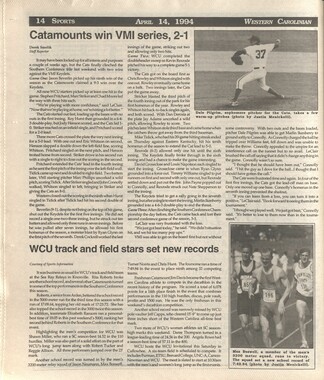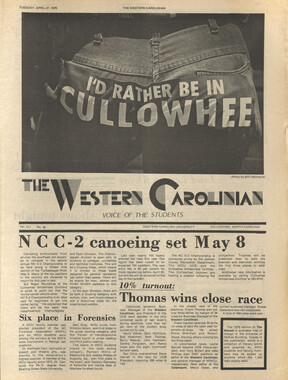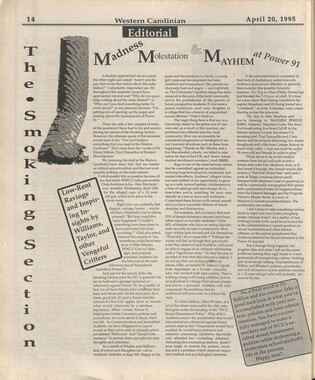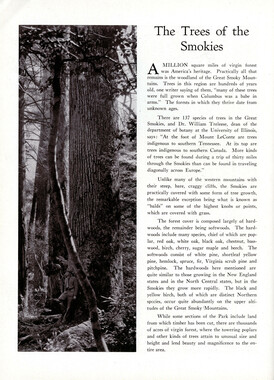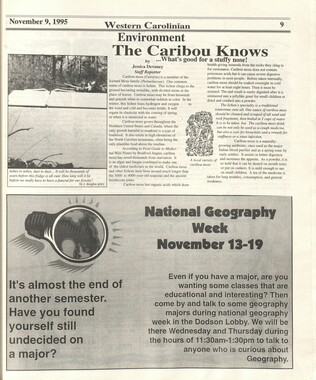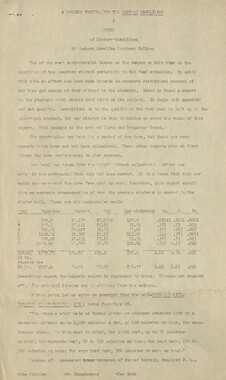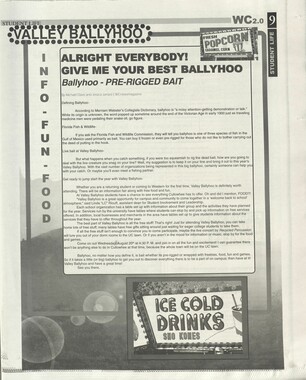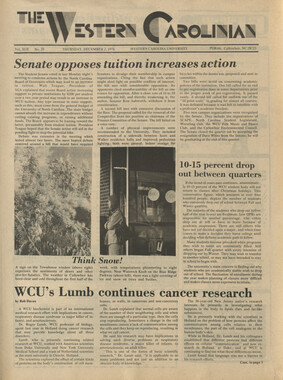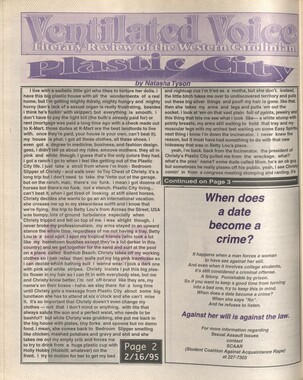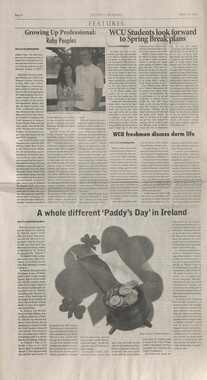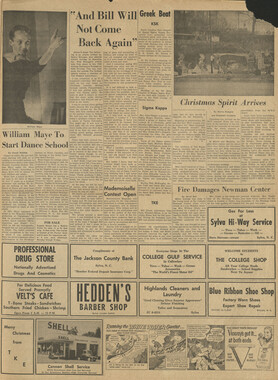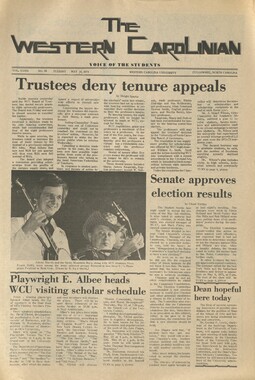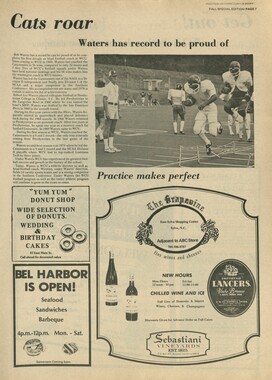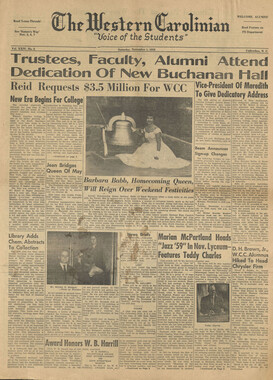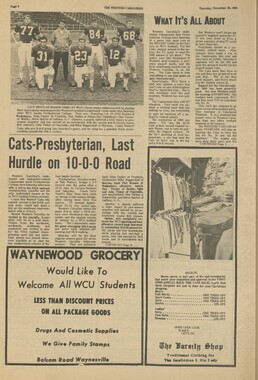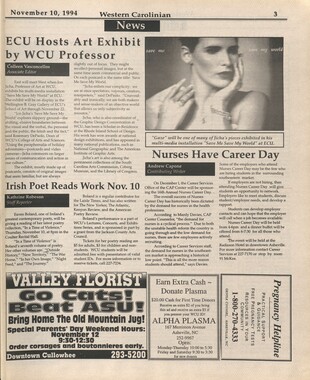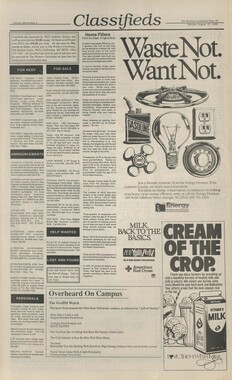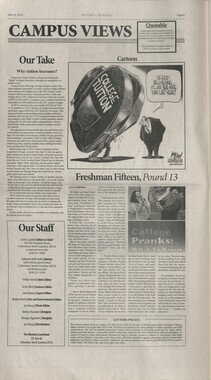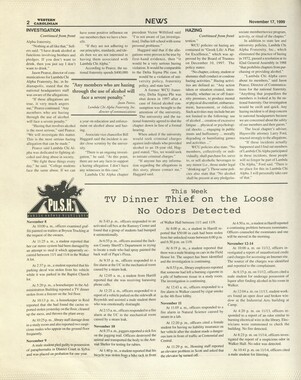Western Carolina University (21)
View all
- Canton Champion Fibre Company (2308)
- Cherokee Traditions (291)
- Civil War in Southern Appalachia (165)
- Craft Revival (1942)
- George Masa Collection (137)
- Great Smoky Mountains - A Park for America (2900)
- Highlights from Western Carolina University (422)
- Horace Kephart (973)
- Journeys Through Jackson (159)
- LGBTQIA+ Archive of Jackson County (85)
- Oral Histories of Western North Carolina (316)
- Picturing Appalachia (6797)
- Stories of Mountain Folk (413)
- Travel Western North Carolina (153)
- Western Carolina University Fine Art Museum Vitreograph Collection (129)
- Western Carolina University Herbarium (92)
- Western Carolina University: Making Memories (738)
- Western Carolina University Publications (2491)
- Western Carolina University Restricted Electronic Theses and Dissertations (146)
- Western North Carolina Regional Maps (71)
- World War II in Southern Appalachia (131)
University of North Carolina Asheville (6)
View all
- Allanstand Cottage Industries (62)
- Appalachian National Park Association (53)
- Bennett, Kelly, 1890-1974 (1463)
- Berry, Walter (76)
- Brasstown Carvers (40)
- Carver, George Washington, 1864?-1943 (26)
- Cathey, Joseph, 1803-1874 (1)
- Champion Fibre Company (233)
- Champion Paper and Fibre Company (297)
- Cherokee Indian Fair Association (16)
- Cherokee Language Program (22)
- Crowe, Amanda (40)
- Edmonston, Thomas Benton, 1842-1907 (7)
- Ensley, A. L. (Abraham Lincoln), 1865-1948 (275)
- Fromer, Irving Rhodes, 1913-1994 (70)
- George Butz (BFS 1907) (46)
- Goodrich, Frances Louisa (120)
- Grant, George Alexander, 1891-1964 (96)
- Heard, Marian Gladys (60)
- Kephart, Calvin, 1883-1969 (15)
- Kephart, Horace, 1862-1931 (313)
- Kephart, Laura, 1862-1954 (67)
- Laney, Gideon Thomas, 1889-1976 (439)
- Masa, George, 1881-1933 (61)
- McElhinney, William Julian, 1896-1953 (44)
- Niggli, Josephina, 1910-1983 (10)
- North Carolina Park Commission (105)
- Osborne, Kezia Stradley (9)
- Owens, Samuel Robert, 1918-1995 (11)
- Penland Weavers and Potters (36)
- Roberts, Vivienne (15)
- Roth, Albert, 1890-1974 (142)
- Schenck, Carl Alwin, 1868-1955 (1)
- Sherrill's Photography Studio (2565)
- Southern Highland Handicraft Guild (127)
- Southern Highlanders, Inc. (71)
- Stalcup, Jesse Bryson (46)
- Stearns, I. K. (213)
- Thompson, James Edward, 1880-1976 (226)
- United States. Indian Arts and Crafts Board (130)
- USFS (683)
- Vance, Zebulon Baird, 1830-1894 (1)
- Weaver, Zebulon, 1872-1948 (58)
- Western Carolina College (230)
- Western Carolina Teachers College (282)
- Western Carolina University (2008)
- Western Carolina University. Mountain Heritage Center (18)
- Whitman, Walt, 1819-1892 (10)
- Wilburn, Hiram Coleman, 1880-1967 (73)
- Williams, Isadora (3)
- Cain, Doreyl Ammons (0)
- Crittenden, Lorraine (0)
- Rhodes, Judy (0)
- Smith, Edward Clark (0)
- Appalachian Region, Southern (2940)
- Asheville (N.C.) (1944)
- Avery County (N.C.) (26)
- Blount County (Tenn.) (195)
- Buncombe County (N.C.) (1680)
- Cherokee County (N.C.) (283)
- Clay County (N.C.) (556)
- Graham County (N.C.) (238)
- Great Smoky Mountains National Park (N.C. and Tenn.) (525)
- Haywood County (N.C.) (3573)
- Henderson County (N.C.) (70)
- Jackson County (N.C.) (4919)
- Knox County (Tenn.) (35)
- Knoxville (Tenn.) (13)
- Lake Santeetlah (N.C.) (10)
- Macon County (N.C.) (421)
- Madison County (N.C.) (216)
- McDowell County (N.C.) (39)
- Mitchell County (N.C.) (135)
- Polk County (N.C.) (35)
- Qualla Boundary (982)
- Rutherford County (N.C.) (78)
- Swain County (N.C.) (2185)
- Transylvania County (N.C.) (270)
- Watauga County (N.C.) (12)
- Waynesville (N.C.) (86)
- Yancey County (N.C.) (72)
- Aerial Photographs (3)
- Aerial Views (60)
- Albums (books) (4)
- Articles (1)
- Artifacts (object Genre) (228)
- Bibliographies (1)
- Biography (general Genre) (2)
- Cards (information Artifacts) (38)
- Clippings (information Artifacts) (192)
- Copybooks (instructional Materials) (3)
- Crafts (art Genres) (622)
- Depictions (visual Works) (21)
- Design Drawings (1)
- Digital Moving Image Formats (2)
- Drawings (visual Works) (185)
- Envelopes (101)
- Exhibitions (events) (1)
- Facsimiles (reproductions) (1)
- Fiction (general Genre) (4)
- Financial Records (12)
- Fliers (printed Matter) (67)
- Glass Plate Negatives (381)
- Guidebooks (2)
- Internegatives (10)
- Interviews (817)
- Land Surveys (102)
- Letters (correspondence) (1045)
- Manuscripts (documents) (618)
- Maps (documents) (177)
- Memorandums (25)
- Minutes (administrative Records) (59)
- Negatives (photographs) (6090)
- Newsletters (1290)
- Newspapers (2)
- Notebooks (8)
- Occupation Currency (1)
- Paintings (visual Works) (1)
- Pen And Ink Drawings (1)
- Periodicals (193)
- Personal Narratives (10)
- Photographs (12976)
- Plans (maps) (1)
- Poetry (6)
- Portraits (4568)
- Postcards (329)
- Programs (documents) (181)
- Publications (documents) (2444)
- Questionnaires (65)
- Relief Prints (26)
- Sayings (literary Genre) (1)
- Scrapbooks (282)
- Sheet Music (2)
- Slides (photographs) (402)
- Songs (musical Compositions) (2)
- Sound Recordings (796)
- Specimens (92)
- Speeches (documents) (18)
- Tintypes (photographs) (8)
- Transcripts (324)
- Text Messages (0)
- A.L. Ensley Collection (275)
- Appalachian Industrial School Records (7)
- Appalachian National Park Association Records (336)
- Axley-Meroney Collection (2)
- Bayard Wootten Photograph Collection (20)
- Bethel Rural Community Organization Collection (7)
- Blumer Collection (5)
- C.W. Slagle Collection (20)
- Canton Area Historical Museum (2110)
- Carlos C. Campbell Collection (462)
- Cataloochee History Project (64)
- Cherokee Studies Collection (4)
- Daisy Dame Photograph Album (5)
- Daniel Boone VI Collection (1)
- Doris Ulmann Photograph Collection (112)
- Elizabeth H. Lasley Collection (1)
- Elizabeth Woolworth Szold Fleharty Collection (4)
- Frank Fry Collection (95)
- George Masa Collection (173)
- Gideon Laney Collection (452)
- Hazel Scarborough Collection (2)
- Hiram C. Wilburn Papers (28)
- Historic Photographs Collection (236)
- Horace Kephart Collection (861)
- Humbard Collection (33)
- Hunter and Weaver Families Collection (1)
- I. D. Blumenthal Collection (4)
- Isadora Williams Collection (4)
- Jesse Bryson Stalcup Collection (47)
- Jim Thompson Collection (224)
- John B. Battle Collection (7)
- John C. Campbell Folk School Records (80)
- John Parris Collection (6)
- Judaculla Rock project (2)
- Kelly Bennett Collection (1482)
- Love Family Papers (11)
- Major Wiley Parris Civil War Letters (3)
- Map Collection (12)
- McFee-Misemer Civil War Letters (34)
- Mountain Heritage Center Collection (4)
- Norburn - Robertson - Thomson Families Collection (44)
- Pauline Hood Collection (7)
- Pre-Guild Collection (2)
- Qualla Arts and Crafts Mutual Collection (12)
- R.A. Romanes Collection (681)
- Rosser H. Taylor Collection (1)
- Samuel Robert Owens Collection (94)
- Sara Madison Collection (144)
- Sherrill Studio Photo Collection (2558)
- Smoky Mountains Hiking Club Collection (616)
- Stories of Mountain Folk - Radio Programs (374)
- The Reporter, Western Carolina University (510)
- Venoy and Elizabeth Reed Collection (16)
- WCU Gender and Sexuality Oral History Project (32)
- WCU Mountain Heritage Center Oral Histories (25)
- WCU Oral History Collection - Mountain People, Mountain Lives (71)
- WCU Students Newspapers Collection (1923)
- Western North Carolina Tomorrow Black Oral History Project (69)
- William Williams Stringfield Collection (2)
- Zebulon Weaver Collection (109)
- African Americans (390)
- Appalachian Trail (35)
- Artisans (521)
- Cherokee art (84)
- Cherokee artists -- North Carolina (10)
- Cherokee language (21)
- Cherokee pottery (101)
- Cherokee women (208)
- Church buildings (190)
- Civilian Conservation Corps (U.S.) (111)
- College student newspapers and periodicals (2012)
- Dams (108)
- Dance (1023)
- Education (222)
- Floods (63)
- Folk music (1015)
- Forced removal, 1813-1903 (2)
- Forest conservation (220)
- Forests and forestry (1197)
- Gender nonconformity (4)
- Great Smoky Mountains National Park (N.C. and Tenn.) (181)
- Hunting (46)
- Landscape photography (25)
- Logging (119)
- Maps (83)
- Mines and mineral resources (9)
- North Carolina -- Maps (18)
- Paper industry (38)
- Postcards (255)
- Pottery (135)
- Railroad trains (72)
- Rural electrification -- North Carolina, Western (3)
- School integration -- Southern States (2)
- Segregation -- North Carolina, Western (5)
- Slavery (5)
- Sports (452)
- Storytelling (243)
- Waterfalls -- Great Smoky Mountains (N.C. and Tenn.) (66)
- Weaving -- Appalachian Region, Southern (280)
- Wood-carving -- Appalachian Region, Southern (328)
- World War, 1939-1945 (173)
Western Carolinian Volume 76 Number 10
Item
Item’s are ‘child’ level descriptions to ‘parent’ objects, (e.g. one page of a whole book).
-
-
Page 3 WESTERN CAROLINIAN August 20, 2010 NEWS Louis Buck named WCUs Perdue signs bill to protect NC coast interim business dean From Staff Reports Louis E. Buck Jr, the Wesley Elingburg Distin- guished Professor of Busi- ness Innovation and director of the Center for Entrepre- neurship and Innovation at Western Carolina University, will serve as interim dean of WCUs College of Business. Announcement of the ap- pointment was recently made by Linda Seestedt-Stanford, WCUs interim provost. Buck will be leading the College of Business while a national search is conducted for a permanent dean to fill a vacancy created by the de- parture of Ronald A. John- son, who stepped down from the post June 30 to become WCUs first BB&T Distin- guished Professor of Capital- ism. The appointment of Buck as interim dean was effective Aug. 1. He will lead the col- lege as it seeks reaccredita- tion by the Association to Advance Collegiate Schools of Business. Dr. Buck has a record of achievement at WCU, lead- ing a very effective depart- ment and being a contribut- ing member of the university community, Seestedt-Stan- ford said. His background in the business world and his life experiences position him well to support the College of Business faculty and staff. T couldnt be more pleased to have Louis as a part.of.my leadership team. -- 3 Formerly | chief financial officer for the competitive businesses of Consolidated Edison in New York, Buck joined the WCU faculty in 2007 as Elingburg Distin- guished Professor of Busi- ness Innovation. He will ray continue in the professorship role while serving as interim dean. He has more than 25 years of leadership experi- ence in corporate finance, accounting and strategic planning. Formerly vice president and CFO of the N.C. Electric Member- ship Corporation, Buck has taught at the University of Texas, University of Dallas and Texas A&M University, and is a retired U.S. Navy fess offers top-ranked pro- grams in project manage- ment and entrepreneurship, both available online. Fully accredited by the Associa- tion to Advance Collegiate Schools of Business-Interna- tional, the college has more s College of Busi Cen than 65 full-time faculty members. The College of Business offers undergraduate shore oil spills from lim- _ its on the recovery of dam- ages from a discharge of hazardous _ substances. _ bill also makes clear that 1i- _ ability applies regardless of The the location of the spill and _ that any damages caused by | cleanup techniques such as ~ chemical dispersants are also included. Its critical to the future of North Carolina that we rotect our coastal families _ and businesses from even the _ slightest possibility of natu- _ ral gas, oil, or drilling waste ' reaching our coastal fishing _and offshore waters, i-Sen. ee Dickson. said While North Carolina may be known for its beautiful _ beaches and quaint mountain ' towns, the Tar Heel State now another distinction, though "not quite as appealing. North _ Carolina now leads the nation and in copperhead snake bites ac- graduate degrees in account- cording to a recent report by ing, finance, information systems, economics, ness administration and law, sport management, global management and strategy, entrepreneurship, sales and marketing, and hospitality and tourism. The college also houses the Center for Professional nnovation, and | the Center for Information busi- ' venomous snakes that cause the majority of snake bite _ poisonings (copperhead, cot- _ the Carolinas Poison Center. North Carolina has five _tonmouth, eastern diamond- back, pygmy, and timber), but its the copperhead that _ causes the most bites. Cop- _ perheads are not usually ag- i akes, bi ill Pp C \ or to secure - food, Children who are playing outdoors and from oil spill damages | Continued from Front | eee Our coastal resources are a critical component of the states economy: the Outer Banks alone draw 7 mil- lion visitors each year, while coastal tourism and fishing spur well over $2.1 billion in spending each year, This bill is a common sense way to protect North Carolinas coast from the dangers of offshore drilling, at the same time enacting one of the strongest laws in the nation that will protect our shores for future generations, said Rep. Pricey Harrison. The bill directs the De- partment of Crime Control and Public Safety to imme- diately review any potential aici: of oil leaking from all reported snake bites are dry, which means venom is not injected. Most bites can be treated with wound care and pain management. Some serious bites require anti- venom. July and August are the most common months for people to get bitten. Snake bites happen in urban and rural areas. Unfor- tunately, North Carolina has a high occurrence of snake bites because of the number of snakes we have native to our area. Pine straw, dried leaves, and wood piles are all popular hideouts for snakes, said Anna Dulaney, Assistant Director of Education for Carolinas Poison Center. the Deepwater Horizon on the North Carolina Coast and update the States Oil Spill Contingency Plan accord- ingly to ensure the states preparedness in the improba- ble event that the oil leaking from the Deepwater Horizon makes it into North Caro- linas waters. The bill also provides for a review of information per- taining to an offshore fossil fuel facility located in coast- al fishing waters to deter- mine consistency with state guidelines. Senate Bill 836 has be- come a model for other states as they prepare legisla- tion in response to the Gulf oil et | NC now number one in in copperhead snake bites ie Staff Reports - If you see a snake, do not try. to catch or kill it. Back away slowly and keep chil- dren or pets away until you dont see the snake anymore. - If you are bitten, dont panic. Do not ice the wound or apply a tourniquet. Dont cut the wound and attempt to suck out the venom. Do keep the bite site still and seek medical attention right away. Call the poison center if you have questions about snake bites. Carolinas Poison Center (CPC) offers North Carolina residents 24/7 free and pri- vate assistance with suspect- ed and actual poisonings. The CPC is staffed by specialists ready to help manage a vari- 4, - Following are some ps toavoid a snakebite: !. | _ ety of poison exposures. Ex- 4Make suryour ' unite amples of possible poisons foundation area is clear of include household products, Technology and Assurance, adults who are gardening are and is home to one of the 17 especially at risk for snake regional offices of the North _ bites. Carolina Small Business and In 2009, 499 snake bites Technology Development were reported to Carolinas Center. Poison Center. Of those, _ 228 were identified as cop- Active Atlantic hurricane season still expected st P's About 30% ot Justin Caudell | Editor-in-Chief A mundane hurricane sea- son so far in the United States is still expected to reach an active level according to an update to a spring forecast released by the National Oce- anic and Atmospheric Asso- ciation (NOAA). As predicted last spring, La Nifia has formed in the tropical Pacific Ocean. This favors lower wind shear over the Atlantic Basin, allowing storm clouds to grow and or- ganize. Other climate factors pointing to an active hurri- cane season are warmer-than- average water in the tropical Atlantic and Caribbean, and the tropical multi-decadal signal, which since 1995 has brought favorable ocean and atmospheric conditions in unison, leading to more ac- tive seasons. August heralds the start of the most active phase of the Atlantic hurricane season and with the meteorologi- cal factors in place, now is the time for everyone living in hurricane prone areas to be prepared, said Jane Lub- chenco, Ph.D., under secre- tary of commerce for oceans and atmosphere and NOAA administrator. Across the entire Atlantic Basin for the rest of the hur- ricane season, which ends on November 30, NOAAs updated outlook is project- ing, with a 70 percent prob- ability, a total of 14 to 20 named storms (top winds of 39mph or higher). Eight to 12 of those storms are expected to reach hurricane strength (74mph or higher), of which four to six could become ma- jor hurricanes (Category 3, 4 or 5 or winds of at least 1timph). These figures in- clude the three storms so far this season: Alex, Bonnie and Colin, none of which touched American soil. The predicted ranges are still indicative of an active season, compared to the av- erage of 11 named storms, six hurricanes and two major hurricanes; however, the up- per bounds of the ranges have been lowered from. the initial outlook in late May, which re- flected the possibility of even more early season activity. The pre-season outlook called for 14-23 named storms with eight to 14 of them becoming hurricanes. According to data from the National Hurricane Cen- ter, the calm start to the 2010 hurricane season is not a reli- able indicator of the overall activity for the entire season. On average only one or two storms form during an Atlan- tic Hurricane Seasons first two months and the 1992 At- lantic hurricane season, for example, had a below-normal number of named storms and hurricanes still had dangerous activity. The first storm did not form until late August that year, when Hurricane An- drew hit southern Florida as a destructive Category 5 storm. Andrew caused 15 deaths di- rectly, 25 deaths indirectly and $30-billion in property damage, making it the costli- est disaster in United States history. All indications are for considerable activity during the next several months, said Gerry Bell, Ph.D., lead sea- sonal hurricane forecaster at NOAAs Climate Prediction Center. As we've seen in past years, storms can come on quickly during the peak months of the season. There remains a high likelihood that the season could be very ac- tive, with the potential of be- ing one of the more active on record, The Federal Emergen- cy Management Agency (FEMA) admits that mod- ern technology, which aids NOAA in predicting hurri- canes, has helped to suggest how many storms will form but not predict when disasters such as Andrew will occur. NOAAs outlooks are extremely valuable when de- termining cycles and trends for the season, however they dont tell us when the next storm will occur or where it may strike, said FEMA ad- ministrator Craig Fugate. It only takes one storm to put a community at risk. That is why we need to take action and prepare ourselves and our families before the next storm hits, including developing a family disaster plan. By tak- ing a few simple steps now we can help ensure that we are better prepared and that our first responders are able to focus on our most vulner- able citizens. debris. : - Dont allow shrubs to be- come overgrown. - Dont store wood piles right up against the house. - Keep grass trimmed. - Wear shoes when out- side. became known. And it is why we want to take a moment fo say a few things about people living with HIV/AIDS in Wester North Carolina. www.wneap.org/iknow chemicals, carbon monoxide, drugs (prescription, over-the- counter, herbal, or illegal), snake bites, and spider bites. Call 1-800-222-1222 for a poison exposure or to request information about poisons.
Object
Object’s are ‘parent’ level descriptions to ‘children’ items, (e.g. a book with pages).
-
The Western Carolinian is Western Carolina University's student-run newspaper. The paper was published as the Cullowhee Yodel from 1924 to 1931 before changing its name to The Western Carolinian in 1933.
-
